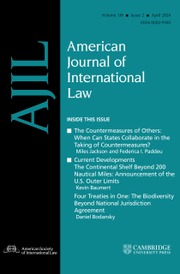No CrossRef data available.
Article contents
Rebel Courts: The Administration of Justice by Armed Insurgents. By René Provost. Oxford, UK: Oxford University Press, 2021. Pp. xi, 474. Index.
Review products
Published online by Cambridge University Press: 17 October 2024
Abstract
- Type
- Book Reviews
- Information
- Copyright
- Copyright © The Author(s), 2024. Published by Cambridge University Press on behalf of American Society of International Law
References
1 See further Bellal, Annyssa, Welcome on Board: Improving Respect for International Humanitarian Law Through the Engagement of Armed Non-State Actors, 19 Y.B. Int'l Humanitarian L. 37 (2017)Google Scholar.
2 See some examples of these practices, that were in flagrant violations of international law, at p. 114.
3 Matthew Bamber-Zyrd, ICRC Engagement with Armed Groups in 2023, Humanitarian L. & Pol'y (Oct. 10, 2023), at https://blogs.icrc.org/law-and-policy/2023/10/10/icrc-engagement-with-armed-groups-in-2023.
4 Annyssa Bellal, Pascal Bongard & Ezequiel Heffes, From Words to Deeds, A Study of Armed Non-state Actors’ Practice and Interpretation of International Humanitarian Law and Human Rights, Research and Policy Conclusions, UK Res. & Innovation, 12–17 (Sept. 2022), at https://words2deeds.org/wp-content/uploads/2022/09/Words2Deeds_comparative-study.pdf.
5 See, e.g., Peter G. Thompson, Armed Groups: The 21st Century Threat 75–95 (2014).
6 See in that sense the 2016 ICRC Commentary of Common Article 3 to the Four Geneva Conventions of 1949, paras. 422–34, at https://ihl-databases.icrc.org/en/ihl-treaties/gci-1949/article-3/commentary/2016?activeTab=undefined#_Toc465169867.
7 Which provides that: “1. This Protocol, which develops and supplements Article 3 common to the Geneva Conventions of 12 August 1949 without modifying its existing conditions of application, shall apply to all armed conflicts which are not covered by Article 1 of the Protocol Additional to the Geneva Conventions of 12 August 1949, and relating to the Protection of Victims of International Armed Conflicts (Protocol I) and which take place in the territory of a High Contracting Party between its armed forces and dissident armed forces or other organized armed groups which, under responsible command, exercise such control over a part of its territory as to enable them to carry out sustained and concerted military operations and to implement this Protocol.” Protocol Additional to the Geneva Conventions of 12 August 1949, and Relating to the Protection of Victims of Non-international Armed Conflicts (Protocol II), Art. 1, June 8, 1977, 1125 UNTS 609, at https://ihl-databases.icrc.org/en/ihl-treaties/apii-1977/article-1?activeTab=default.
8 See, for example, in social science research methods, Markman, A.B. & Gentner, D., Commonalities and Differences in Similarity Comparisons, 24 Memory & Cognition 235 (1996)CrossRefGoogle Scholar.
9 Ezequiel Heffes, From Words to Deeds: A Research Study of Armed Non-state Actors’ Practice and Interpretation of International Humanitarian and Human Rights Norms, Fuerzas Armadas Revolucionarias de Colombia – Ejército del Pueblo (Revolutionary Armed Forces of Colombia-People's Army, FARC-EP), 9 (Mar. 2021), at https://words2deeds.org/wp-content/uploads/2021/07/Case-Study-Revolutionary-Armed-Forces-of-Colombia-%E2%80%93-Peoples-Army.pdf.
10 IntelBrief: French Foreign Fighters Sentenced to Death in Iraq, Soufan Ctr. (June 2019), at https://thesoufancenter.org/intelbrief-french-foreign-fighters-sentenced-to-death-in-iraq.
11 1949 Geneva Conventions, Common Art. 3(d), at https://ihl-databases.icrc.org/en/ihl-treaties/gciv-1949/article-3.
12 Notably by Marco Sassòli, International Humanitarian Law: Rules, Controversies, and Solutions to Problems Arising in Warfare 587 (2019).


